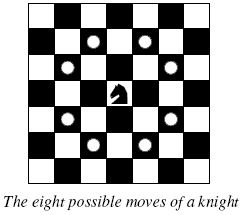|
A Knight's Journey
Description  Background
Background
The knight is getting bored of seeing the same black and white squares again and again and has decided to make a journey around the world. Whenever a knight moves, it is two squares in one direction and one square perpendicular to this. The world of a knight is the chessboard he is living on. Our knight lives on a chessboard that has a smaller area than a regular 8 * 8 board, but it is still rectangular. Can you help this adventurous knight to make travel plans? Problem Find a path such that the knight visits every square once. The knight can start and end on any square of the board. Input
The input begins with a positive integer n in the first line. The following lines contain n test cases. Each test case consists of a single line with two positive integers p and q, such that 1 <= p * q <= 26. This represents a p * q chessboard, where p describes how many different square numbers 1, . . . , p exist, q describes how many different square letters exist. These are the first q letters of the Latin alphabet: A, . . .
Output
The output for every scenario begins with a line containing "Scenario #i:", where i is the number of the scenario starting at 1. Then print a single line containing the lexicographically first path that visits all squares of the chessboard with knight moves followed by an empty line. The path should be given on a single line by concatenating the names of the visited squares. Each square name consists of a capital letter followed by a number.
If no such path exist, you should output impossible on a single line. Sample Input 3 1 1 2 3 4 3 Sample Output Scenario #1: A1 Scenario #2: impossible Scenario #3: A1B3C1A2B4C2A3B1C3A4B2C4 Source
TUD Programming Contest 2005, Darmstadt, Germany
|
好久没做dfs,再加上突然搞出来一个字典序,把爹做出翔
其实大家不要被什么字典序唬住了,字典序方面只要处理一些细节就好,主要的还是dfs,相当简单的dfs,全题个人认为有两个比较值得学习的地方,详见代码:
#include<algorithm>
#include<iostream>
#include<cstdio>
#include<cstring>
using namespace std;
int dir[8][2]={{-2,-1},{-2,1},{-1,-2},{-1,2},{1,-2},{1,2},{2,-1},{2,1}};
///本题第一个撸点,因为题目要求要按照字典序输出,所以要先搜索字典序较小的点,即在使坐标第一个值尽量小的情况下再使第二个坐标尽量小。
int p, q;
bool used[100][100];
int path[100][100];
bool flag;
bool check(int x, int y)
{
if(x > 0 && y > 0 && x <= p && y <= q && !used[x][y] && !flag)
return 1;
return 0;
}
void dfs(int x, int y, int step)
{
path[step][0] = x;
path[step][1] = y;
if(step == p*q)
{
///printf("huang\n");
flag = 1;
return;
}
for(int i=0; i<8; ++i)
{
int xx = x + dir[i][1];
int yy = y + dir[i][0];
if(check(xx , yy))
{
used[xx][yy] = 1;
dfs(xx, yy, step+1);
used[xx][yy] = 0;
}
}
}
int main()
{
int cnt, T;
scanf("%d", &T);
cnt = 0;
while(T--)
{
cnt++;
flag = 0;
scanf("%d%d", &p, &q);
memset(used, 0, sizeof(used));
used[1][1]=1;
dfs(1, 1, 1);
/**本题第二个撸点,因为如果棋子能够走遍整个棋盘,那么一定能走到A1,
那么根据从字典序较小的点开始搜索的规律,所有情况都应该从A1开始搜索**/
printf("Scenario #%d:\n", cnt);
if(!flag) printf("impossible\n");
else if(flag)
{
for(int i=1; i<=p*q; ++i)
printf("%c%d", path[i][1]- 1 + 'A', path[i][0]);
printf("\n");
}
if(T != 0) printf("\n");
}
return 0;
}























 787
787

 被折叠的 条评论
为什么被折叠?
被折叠的 条评论
为什么被折叠?








